Mary Fleming's Blog, page 4
February 25, 2023
New Friends
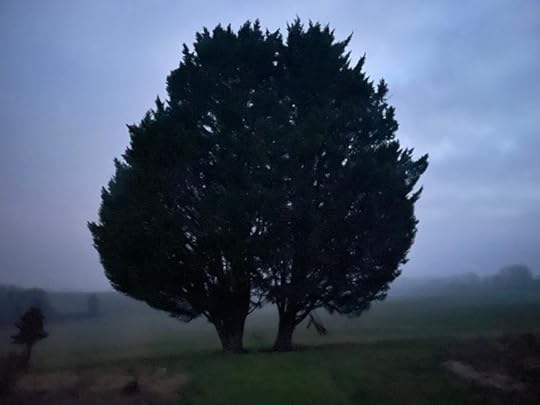
Friday, 24 February
Here's a new word for (most of) you: dendrolatry, the worship of trees. My admiration may not quite attain the level of adoration, but this winter I've been counting my arboreal blessings.
When you buy a property in the country, it's not just the bricks (or in our case stone) and mortar that become part of your life. It's also the surrounding nature, and chez nous anyway, that means lots of trees. If at first they appeared as one vegetal mass, over time individuals have come into focus and distinguished themselves, each with their own story, their own essence.
The most obvious are the towering hemlocks you see above. They greet you as you come over the rise and dominate the view out back. From an old aerial photo that the previous owners Frédéric and Corinne passed on to us, I know that they are the only survivors to a line that used to divide the back garden between house and barn. Though they obviously haven't been around as long as the 500-year old house, today they mark the property like a coat of arms.
Then in front there's the lone lime tree, a commonly planted species in a French farmyard, and a daily reminder of Deux Champs' agricultural heritage.
 Central casting
Central castingOther members of our household include the huge elm that somehow escaped the Dutch plague which killed most of its brethren in Europe and America...
 Survival of the fittest
Survival of the fittest...and the small oak that enriches our sunsets...
 Crazy hairdo
Crazy hairdo...or the willow that we found buried when removing the monster thuya hedges that used to block the view of pretty much everything. As a result of injuries sustained during its captivity, we trimmed it back to its bare bones for fear it would split in two.
 Existential moment
Existential momentAnd if you walk a lot, as I do with the Indefatigable One (the yellow-vested canine you see above, aka Tasha), certain trees beyond your own garden become points of reference, even in some cases, companions.
Since moving here, I’ve learned that trees are often planted or left to grow for a reason. Monsieur L, for example, the farmer from whom we bought the fields, told me he tilled in line with these two poplars because they mark the end of our property:
 Standing out
Standing outRecently, to avoid slurping along a muddy path, I started walking at the edge of the adjacent field and realised that this tree marks a gap in the hedge where I can cross to the other side:
 Enter stage right
Enter stage rightThen there are the trees that I check in on every day and photograph somewhat obsessively (examples already abound in this Diary). The monster cedars that live in the park at what we call the General’s House and that glower or glow in the sky, depending on the weather and time of day.
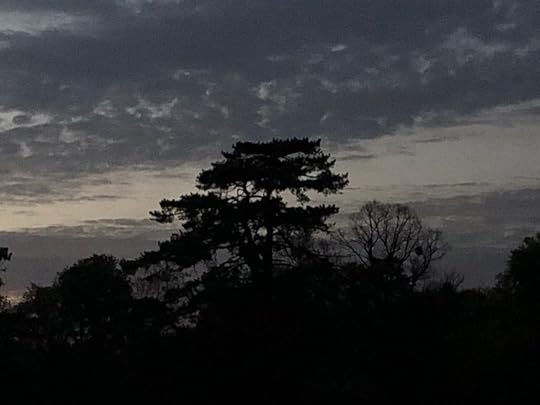
And the tortured oak that lives alone in a field that Tasha and I walk by at least twice a day.

Not to dwell exclusively on the deeply rooted: we are also adding significantly to the community by planting (under green guru Claire's supervision) many new members, such as this lithe maple.

If I'm writing about the trees in my life now, this end of February, it's because - as I hope the above photos illustrate - their lacey, winter-lit beauty takes my breath away every day, makes me feel lucky to be alive. If I were a religious person, I could indeed believe such good fortune was heaven sent.
 The Community
The Community_____________
You can visit my website here and follow me on my Instagram here
February 11, 2023
Building Time
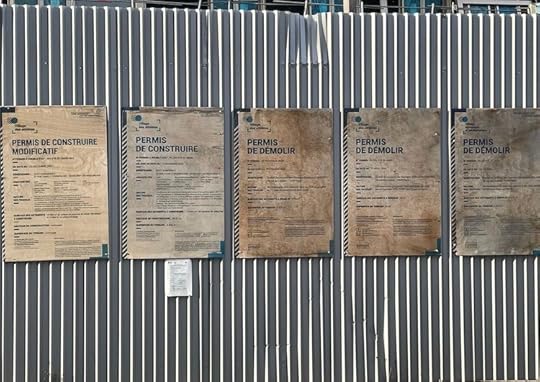
Friday, 10 February
Early on in my Paris years, I learned an expression that made me feel I really knew my way around town: les dix minutes parisiennes. It means that whether you are attending a meeting and certainly a dinner party in Paris, you are not only allowed to be ten minutes late, it is almost expected.
I don’t know if the working world here has become Anglo-Saxonised to the point of punctuality, but I am still appreciative when my dinner guests afford me that 10-minute cushion.
Lately I’ve been wondering if the tendency of Parisiens to run late might not be about to get the whole country in trouble.
 Late for an important date
Late for an important dateNext year France is hosting the Summer Olympics, and even though the Games are still another 17 months away (the Olympics are from 24 July-11 August and the Paralympics from 28 August to 8 September 2024), it’s hard to see how the city is going to be ready to receive 14,000 athletes and 600,000 visitors.
As I’ve noted on more than one occasion, and as you can see above and below, everywhere you look are works that seem nowhere near finished.
 'This is a mess!' cried the statue
'This is a mess!' cried the statueLately I’ve also been wondering about the readiness of construction projects for the games themselves.
According to its website, the Olympic Village, for example, located just north of Paris in the towns of Saint Ouen and Saint Denis and near the Stade de France, is well underway. The developers claim the project, which will be converted into living space for real people once the Olympians leaves, “embodies 21st century urban planning, through good energy performance, carbon neutrality and strong emphasis on biodiversity. The redevelopment of the area is also designed to promote 'living together' and the development of an inclusive society, taking into account the diversity of needs of each citizen, in particular those with disabilities." (for details and drawings, look on the site)
Since you can't believe everything you read, yesterday I went to see this Shangri-La in the making for myself.
 Carrefour Pleyel, where once the piano maker had his atelier
Carrefour Pleyel, where once the piano maker had his atelierWhen I emerged from the closest métro stop to the Village, I walked the wrong way, and my fears of Paris being late for the show only amplified. A major road project in the vicinity looks to be in the early stages.

Approaching the Stade de France and looking at my phone to reorient myself, I almost fell over this.
 Stumbling block
Stumbling blockOnce I actually got to the heart of the Village, the situation looked more hopeful...
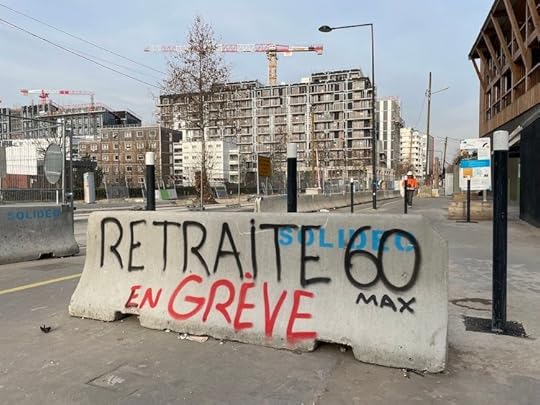
...though there are early signs of trouble in paradise (opposition to President Macron's retirement reform is expressed on every available surface) and still many forgotten corners...
 "The rich are stealing our retirement money"
"The rich are stealing our retirement money"But as I crossed the street from the future Village to the old St Ouen, I stopped thinking about timing and started considering time.
 Across the street from paradise
Across the street from paradiseSaint Denis and Saint Ouen, in the department of Seine-Saint-Denis, were traditionally poor, working class suburbs, part of the ceinture rouge, the so-called red belt of left-wing voting banlieues around the edge of Paris.
 Once upon a time, there were castles...
Once upon a time, there were castles...This is not the first time the area has undergone radical change. During les trentes-glorieuses, France's post-war boom years, concrete housing blocks popped up all over the place. They were accused of being soulless, but to people who had been living without central heating and indoor plumbing, it felt like the promised land.
With deindustrialisation, the workers moved out and the immigrants France once courted moved in. The buildings have not aged well.
 Growing old
Growing oldThe towns remain poor and troubled. Average incomes in St Denis and St Ouen are less than 20,000€/$ a year; unemployment hovers around 20% and literacy rates are falling. Particularly the former has a reputation for high crime and drugs. It is often denounced as a hub of Islamist extremism.
On the other hand, as my walk reminded me, it is also a lot livelier than, say, the boring VIIe where I live. Seine-Saint-Denis is the youngest department in France and some would say the most creative. Rap and hip-hop thrive in le neuf-trois (its nickname, in reference to its department number, 93), and verlan (the argot of the banlieues) has made its way into the mouths of Bobo Parisians. "Je vais avec la meuf à la teuf" (I'm going with the girl to the party, which of course sounds much more lyrical in the original).
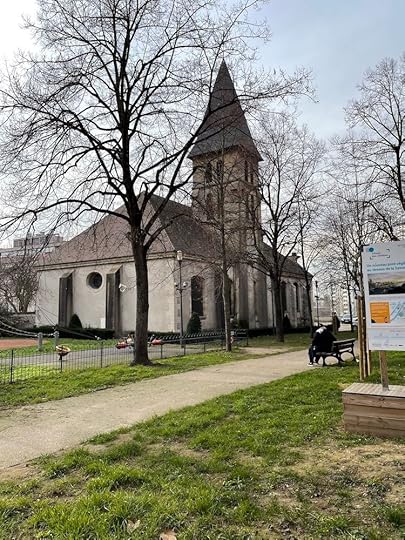
My amble took me further back in time, to when St Ouen really was just a village. The church St-Ouen-le-Vieux, built in the Middle Ages, reputedly on the spot where the saint dropped dead, overlooks the Seine. On the steep escarpment in front, well-tended grape vines are still neatly lined up. To the side stand old stones and, inexplicably, hay bales.
 The randomness of history
The randomness of historyBeyond them is a well-established encampment of the homeless.
 Berlin-sur-Seine
Berlin-sur-SeineHistory in these older parts of town has developed vertically, layer upon layer over the centuries, resulting in lots of unexpected quirks that give the place a soul. It leaves you wondering if the millimetrically planned Olympic approach to community can ever provide depth.
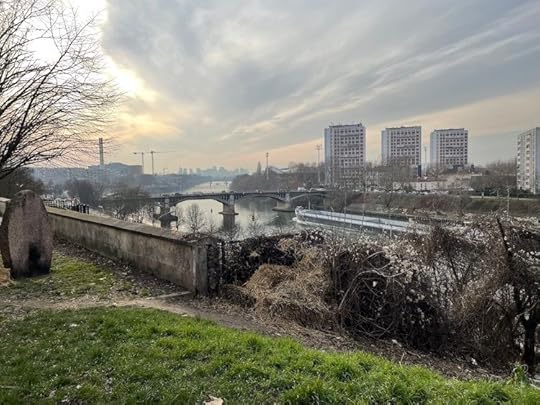
In the view up-river from the church looms the silhouette of another French architectural bubble, La Défense, conceived to provide modern office and living space in the 1960s -70s. It's a weird place today, but in its way, it lives. And the poor suburbs of Paris certainly need a leg up.
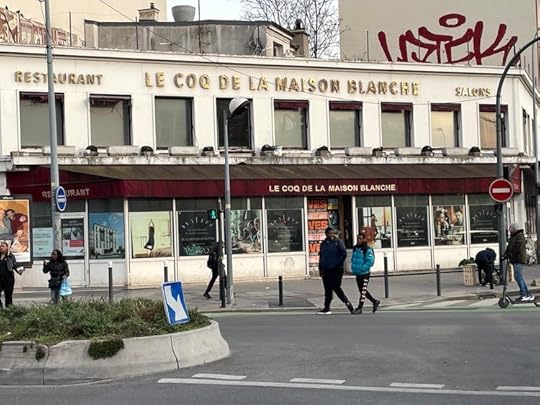
Here's hoping this latest attempt at utopian living goes some way to improving people's lives and enriching the surrounding community. In the meantime, cross your fingers that it gets done on time.
 The way home, Métro Mairie-Saint-Ouen
The way home, Métro Mairie-Saint-Ouen_____________
You can visit my website here and follow me on my Instagram here
January 28, 2023
Notice, and thanks

Friday, 27 January
In January, my Paris dog-walking friend Nathaële and I always remark how the days may be getting longer but to all appearances, not in the morning. Beyond the glare of the city lights on the terraces of the Tuileries Gardens, you can’t see a thing, including your own dog, unless she has a flashing red light attached to her harness.
 Into the dark
Into the darkBut this year, having spent much of the month in the Perche, I see things differently.
Paris or the Perche, I take Tasha on the same route, in the same 7.30-8.30 time slot, every day. In the Perche, I’m the illuminated one, equipped with a headlamp to help me navigate bumpy, muddy, branch-strewn paths. Tasha replaces her bicycle light (it would not survive even one of her romps through the brush) with a gilet jaune to alert over-eager hunters, should she be led astray into the lighter hours of the morning, that she is not game. A side benefit is that I too can see her, and from quite some distance, even in the penumbra.
 Enlightened
EnlightenedThis is our third January in the Perche but the first without major distractions such as the long renovation of our house. With no workers banging and clanging my sensibilities to a pulp, with no vans blocking my view, I am generally more receptive to the world around me. And I have noticed this winter the small but steady matinal increments in daylight. It depends somewhat, of course, on the weather. The grey mornings are less luminous...
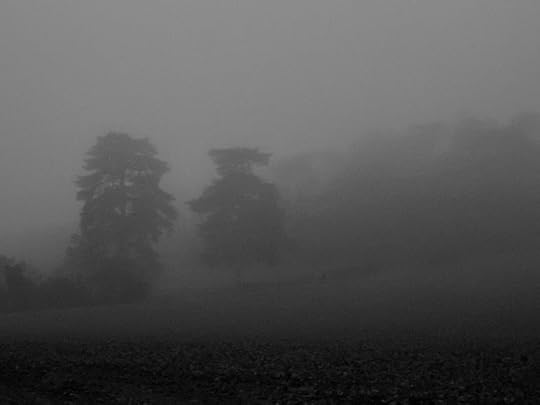
Than those presaging sun...
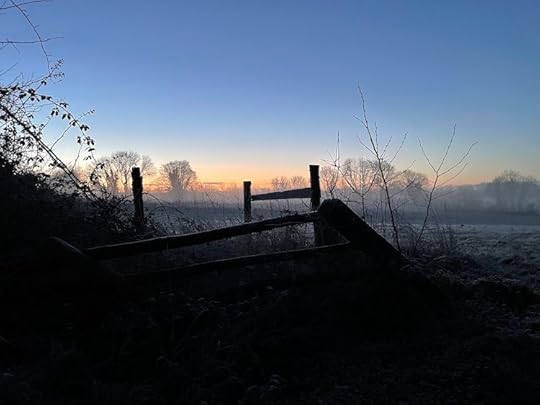
But in the country, minutes matter. I begin to turn off my headlamp several steps earlier every day, and each time it feels like a mark of hope, the promise of a brightening, widening world. Though different internet sites bizarrely give different calculations of daylight each month, according to lecalendrier.fr, we will have gained 66 minutes in January, then 94min in February and 115min in March - indisputable grounds for optimism.
 Towards the light
Towards the lightThis winter I have determined that the light of January in general is a precious but undervalued commodity. The sepia tones of a foggy day prompt melancholic nostalgia...
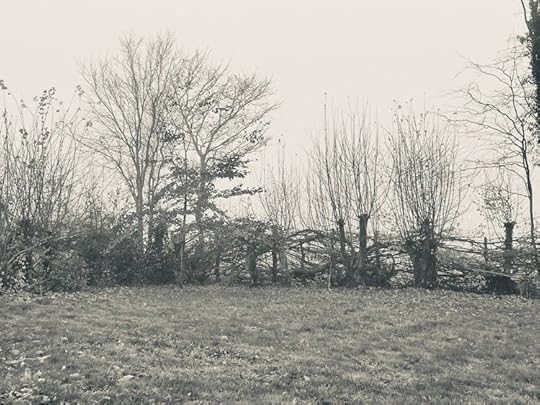
...while frosty mornings boost your energy level...
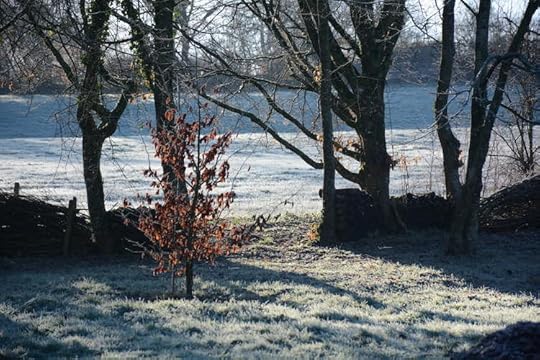
...and reveal nature's design...
 Icy creativity
Icy creativityJanuary light contributes to a variety of moods inside too, from honeyed comfort...
 Cheery winter fruit
Cheery winter fruit...to contemplative introspection...
 Hush
HushLast night I talked to my London friend Victoria, who mentioned having recently attended the Winslow Homer exhibition that just finished at the National Gallery. She serendipitously added that she'd been particularly moved by an extract from a letter Homer sent to his brother and that was quoted in the blurb next to an 1896 Maine Coast painting:
“The life I have chosen gives me the full hours of enjoyment for the balance of my life. The sun will not rise, or set, without my notice, and thanks.”
I couldn't have said it better myself.
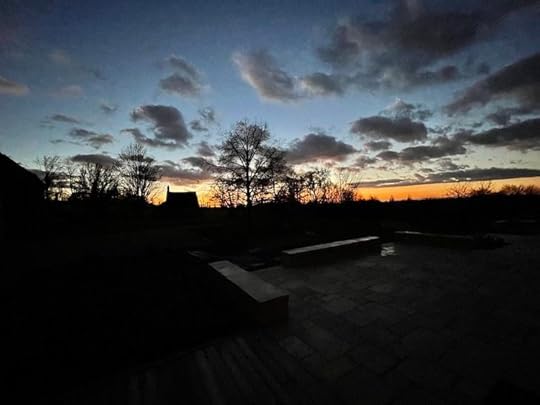 January light at dusk, le Perche
January light at dusk, le Perche_____________
You can visit my website here and follow me on my Instagram here
January 14, 2023
Macro vs Micro
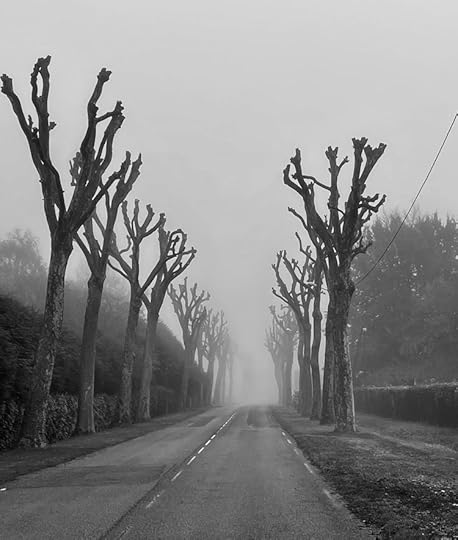
Friday, 13 January
Tell me if you’ve felt anything similar recently*: every time I give or receive a Happy New Year this January – with many of those received accompanied by a Thank God 2022 is over – I experience a small internal wince. The frisson occurs because it seems to me that none of the world's troubles from last year are going away. If anything, the big picture for 2023 is only looking darker.
This morning, in a Financial Times' article by Gillian Tett , I learned that we wincers are not alone: according to a recent JPMorgan Survey, only 8 per cent of American business leaders are “feeling upbeat about the global economy”. Another study cited, the World Economic Forum risk report, shows Davos-goers' top concerns this year are not growth and debt but the threat of nuclear war, the growing perils of climate change and increased social conflict.
 Deconstruction
DeconstructionQuite right. The war in Ukraine grinds on inexorably. Covid continues to kill untold thousands in China and to mutate into new variants, the names of which become ever more science fictional (BQ.1.1; CH.1.1; BF.7; XBB.1.5 – what was wrong with the Greek alphabet?). 2022 temperatures were well above 'average', especially in Europe last summer, and I can't imagine why 2023 would be any cooler, since global carbon emissions continued to rise. Already this January severe weather has ravaged parts of California. Over here in Europe it feels like March. Misinformed birds are singing their spring love songs and the buds are bursting on confused plants.
 Early bloomers
Early bloomersWhile the planet burns, we travel – if possible by private jet – it’s so much more convenient.
 The dogs just love it (The Financial Times)
The dogs just love it (The Financial Times)Those less fortunate than Mr Alecci's dogs are still flocking to the commercial variety of air travel. Global tourism is expected to rise 30% this year, which is one reason that the Louvre museum plans to limit the number of its daily visitors, claiming that this will contribute to 'a more pleasurable viewing experience' (or, one might say, a less disagreeable one)...
 What time's our flight?
What time's our flight?Visitors to Paris may soon find their touring further hindered by trade unions and the gilets jaunes, who are threatening to hit the streets in protest against the Macron government's plan to raise the retirement age from 62 to 64 (the UK, US and Germany are nudging up from around 65 to 67).
 Let them eat cake
Let them eat cakeBoth travellers and non-travellers continue to consume, despite rising inflation and our awareness of the nefarious effects of, say, the fashion industry on our environment. Today we buy 60% more clothes and wear them only half as long as in 2000.
 How many times would I wear these?
How many times would I wear these?The above examples - just a few fun facts that I have gleaned over the last 10 days - are of course only the tip of the melting iceberg.
However: the FT article does go on to say that while CEOs are pessimistic about the larger picture, they are less gloomy about their own companies: 51 per cent think profits will rise this year and 88 per cent plan to keep or add staff (I guess these doesn't include companies such as Meta, Goldman Sachs, Amazon and Twitter, who have recently carried out mass layoffs).
 Adding staff on the home front
Adding staff on the home frontOnce again, I have to agree with the world's managers. While I fret about the macro, the micro's off to a productive start this new year. After calm, only moderately indulgent holidays, I’ve been working, exercising, reading and playing the piano, gently swinging from Paris to the Perche, where our renovation project is beginning to seem very 2022.
There have been early morning walks with Tasha in a hushed Paris...
 Another way to look at art
Another way to look at art...and an even quieter countryside. The only gilet jaune I've seen is on Tasha.

At least if it feels like March, it's raining like spring too, turning the fields and garden an electric green and helping to refill the water tables after the brown, desiccated months of summer.
 After the rain
After the rainThus far, daily life in 2023 has been my idea of heaven. So even if the macro picture is not looking too good, here's wishing you a Happy Micro New Year.
___________________
*New feature for the new year: leave your comments below!
(You can also visit my website here and follow me on my Instagram here)
December 17, 2022
Things, Glorious Things
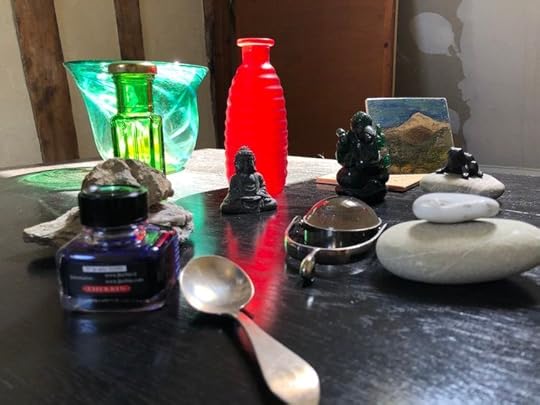
Friday, 16 December
I love things. Big things, little things, things that belong to me and things that do not. Sometimes I am uneasy about this proclivity. It can seem materialistic, trifling, overly personal, boringly bourgeois.
 Measuring out my life with coffee spoons
Measuring out my life with coffee spoonsBut if the current exhibition scene in Paris is any indication, I’m right in the swing of those Things.
 My beloved vintage nightshirt
My beloved vintage nightshirtAt the Palais Galliera, there’s “Frida Kahlo, au-dela des apparences” (beyond appearances), where many of the Mexican artist’s iconic dresses and personal effects are on display. They open a fascinating window onto her creative process and her art.
 My beloved Bösendorfer
My beloved BösendorferTomorrow is the last day for the small exhibition of a little known 17th century Italian painter Evaristo Baschinis at the Galerie Canasso. His delicate, hyper-realistic still lifes of musical instruments, complete with dust and fingerprints, are technically and spiritually captivating.
Then there’s the exhibition at the Louvre, “Les Choses - une histoire de la nature morte”, a history of the still life in general. It's one of the mega-shows I recently wrote about trying to avoid: a highly praised must-see; nothing like it since its avatar in 1952…I could just imagine the hordes.
But: a whole show devoted to things? What I photograph compulsively, what I write about daily (leaning, as I do, on the minutiae of daily life to build plot and character). How could I miss it?
 Piecing things together
Piecing things togetherI planned the trip with care, reserving on a weekday at lunchtime and entering through the Porte des Lions side entrance. Many potential visitors were indeed eating lunch; I waited not a nano-second at either the museum or exhibition entrance and thus joined a manageable crowd, feeling calm and receptive.
 Guiding light
Guiding lightThe show traces les Choses that have inspired art from pre-history to today, in painting, sculpture, photography and video. The 15 sections are chronological and thematic, globally delineating how our relationship to things has become more secular over time, but there’s a lot of mixing and matching in the elegantly earth-toned gallery.
 Faces and vases (Archimboldo and Chardin)
Faces and vases (Archimboldo and Chardin)Different eras, subject matter and media sit seamlessly and evocatively side by side. So in the 19th century “The Simple Life” section, for example, you have Van Gogh’s Bedroom in Arles, 1889 (Vincent did not like things, thus the full-frontal take on his uncluttered quarters) next to another Dutch artist, 17th century Samuel Van Hoogstraten, whose tableau The Slippers is littered with objects (the abandoned slippers of the title, keys, a mop, a candle) that invite the observer to imagine the human who has just slipped away.

Or in the 20th century “In their Solitude” section, the still life artist par excellence Giorgio Morandi’s painting (1944) is bracketed by Sophie Ristelhueber's photo of shoes in the sands of Kuwait, 1992, and a clip from a documentary by the film maker Jean-Daniel Pollet (1997, God Knows What).
 Human objects
Human objectsYou also see how one style or theme segued into another. How, for example, Cézanne's breaking the line on that kitchen table led to the Cubists' fracturing of space altogether or Matisse's flattening and stylising of it.
 Shenanigans underneath that tablecloth
Shenanigans underneath that tableclothAs the show illustrates at several points, it can turn ugly when Things get out of hand. We're not the first generation to experience excess and cupidity - just look at Marinus Van Reymerswale, The Tax Collector (circa 1540) from the 16th century section "Accumulation, Exchange, Market, Pillage".
 Mo-o-o-r-e!
Mo-o-o-r-e!It can get sad. A later section is called "Vanity", as in a sense of futility at our mortality, with lots of rotting fruit and skulls.
 Gerhard Richter's rictus
Gerhard Richter's rictusIn "Modern Times", artists began taking the mickey out of Things. There's a champagne bottle-holder that Marcel Duchamp in his Dada phase bought off the shelf to ridicule the idea of Art as unique creation.

In almost every work I recognised one of my own photos, whether it was the Neolithic hatchet wrapped in clay and plastic in the "What's Left" section...
 Volos (Hubert Duprat, 2013)
Volos (Hubert Duprat, 2013) Georgian version, 2014
Georgian version, 2014...or Georges de la Tour's Magdalene the Smoking Flame (circa 1642)...

 David, 14 November 2015
David, 14 November 2015...or any of Manet's glorious depictions of humble fruit and veg, such as this lemon painted three years before his death.
 Sweet lemon...
Sweet lemon... ...and her friend the lime
...and her friend the limeI could go on and on.
As the curator Laurence Bertrand Dorléac writes, things are important to humans because we share the planet with them. And they are not in fact 'lifeless' but have their own intrinsic character and value. Things hold a host of associations and symbolisms, provide an anchor to memory and therefore mean much more to us than the sum of their often insignificant parts. I could write a short story, for example, around each small item on my desk in the top photo.
I'd even posit that things have a voice of their own. What could be more natural, then, than for humans to help give expression to that voice?
 The right light
The right lightMeandering through Les Choses was like a mind-expanding trip through my own head. Revisiting already beloved works, discovering so many others for the first time, then experiencing their inventive juxtaposition, was pure joy. By the exit, I felt smarter and wiser. And quite at peace with my Thing thing.

Wishing you all a happy festive season, avec plein de bonnes choses.
___________________
You can visit my website here and if you like my photos of Things, there are LOTS more on my Instagram account here
November 26, 2022
With or Without Us
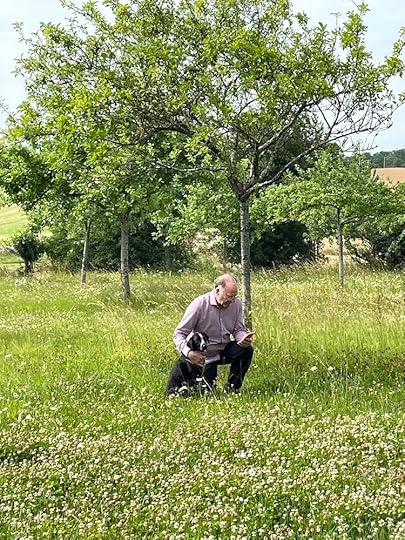
Friday, 25 November
If you’ve read this blog even spottily, you will know that since we bought our house in the Perche in 2019, we’ve altered just about everything, inside and out. Even our fields have changed both farmers and farming practices, as we shifted from 'conventional' (with chemicals) to organic. But there’s one patch that we’ve barely touched: the orchard, where fruit trees abound.

At the beginning, it was largely hidden from view by a massive thuja hedge that ran its length. By felling the monster, we gave the orchard - the whole place, in fact - space to breathe. It now greets the visitor upon arrival, gently prefaces the vista of the countryside from the front of the house and is generally better integrated into life at Deux Champs.
 Learning centre
Learning centreThe fruit trees were planted by our predecessors, Corinne and Frédéric, who thoughtfully left us a plan that included the ripening dates of each specimen, a gauge which sadly, in our climately changing world, no longer provides much guidance.
 Best by dates have expired
Best by dates have expiredThere’s cherry, plum and pear, even a small peach tree and an ancient quince that stopped producing after our first year (a gardening person told me it didn't like all the disruption and having its undergrowth cut away).
 Dine on me
Dine on meThe cherries ripen first, but the trees are tall and much of the fruit beyond my reach, even with the big ladder. The birds also love them, so once ripe, they're here today, gone tomorrow.
 Snatched from the beaks of birds
Snatched from the beaks of birdsPlums come next...
 More on the way
More on the way...or used to. Two springs of an eerily warm March followed by cruel April frosts killed the buds and resulted in drastically diminished returns. Ditto for the pears, of which there have been none since 2020.
 A pair of pears, no more
A pair of pears, no moreBut apple trees (highlighted in pink on the plan) predominate. To spare you the count: there are 24 of them, and almost as many varieties. Either they are trying to thank us for removing the thuja or they love climate change because unlike their brethren, les pommiers have thrived.
 Just a taste
Just a tasteApples have been cultivated in the Perche since the 16th century, mostly for the production of alcoholic cider, which in 2020 earned its own Appellation d’Origine Contrôlée label (protected designation of origin - think Bordeaux and Burgundy wine, Comté and Camembert de Normandie cheeses). Perche cider even has a website. Because we are not the only ones in the area to have industrial levels of production, there’s an association near us, La Reinette Verte, where you can bring your apples and bottles, and they’ll turn it into juice for you.
Since we do not have either a trailer for transport or an overwhelming love of apple juice (not to mention the time and energy to manage all that fruit), some of the Reinette Verte members came one afternoon in October with buckets, tarps and carts to pick apples and haul them away.
Sad to say, they hardly made a dent. Neither have the badgers, or Tasha, who's had her fair share. So I kept picking and making crumbles and compôte, even apple jam. But I'm no match for nature unbound. To abridge Robert Frost: "I am done with apple-picking now....For I have had too much/...I am overtired/Of the great harvest I myself desired." (from his poem "After Apple-Picking")
 Enough
EnoughWhich has led to a lot of rotting apples and the following exchange:
Me: “I can’t pick another apple, but I can't stand seeing all this fruit go to waste. When you think about all the people in the world who don't have enough to eat."
David: "But the trees are not producing the fruit for us. They're just doing their apple tree thing, regardless of whether we are here. Or not."
On one level, his philosophical approach is comforting. Solipsistic beings that we are, we tend to think nature exists for our purposes and ours alone, when in fact she won't care if, say, we do manage to derail the planet completely. From another angle, it was the eating of an apple that got us into such trouble in the first place.
But neither metaphysics nor religion can alter the facts: many of our trees are suffering, while others are producing more than we can use. Not unlike their human counterparts and another sign, should we need it, that things are out of whack.

___________________
November 5, 2022
The Saga of a Swamp
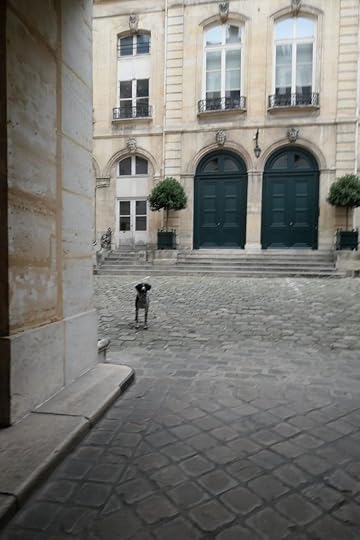
Friday, 4 November
For a long time I've known that the section of the VII arrondissement of Paris where we live was originally a swamp. Yesterday I learned that it was also an area where wood that travelled down the Seine was stocked. Such a place is called un chantier, a word that today is more commonly associated with 'work site', such as the kind that seems to follow (one might even say haunt) us from Berlin to Paris to the Perche and back to Paris again.
Construction intended for human life in our quartier began when the river was channelled and cleaned up in the 17th century. First came some abbeys and convents. Then in 1670, Louis XIV built the military hospital les Invalides, which today is still in part occupied by officers (though not sick ones) and is also home to Napoleon’s tomb and the Museum of the Army.
 Room to grow (Plan de Turgot, 1739)
Room to grow (Plan de Turgot, 1739)Nobles, feeling crowded and bored in the Marais, began building hôtels particuliers (grand townhouses) amidst the vineyards, vegetable patches and fens. The hôtel in the cluster of buildings that constitutes our address (top photo) was constructed in about 1730, just before the Plan de Turgot was drawn and situated beyond the map's top right hand corner. Along with its fraternal twin next door (an early experiment, you could say, in semi-detached living), it was built on spec as rental housing by a wood merchant turned developer. The house is about 1000m2/10,000 square ft. The property included a courtyard, stables for 19 horses, shelter for four carriages and a back garden that extended to the next street.

In the 19th century, when the boulevard Saint Germain nosed its way through the quartier during Baron Haussmann’s remake of the city, the property got squeezed. Stables and carriage houses were built upon and transformed into the apartment building that now gives onto the street and whose porte-cochère (see photo below) leads to the courtyard.
The hôtel further lost its elbow room when our building was tucked in at its side in 1930; the ensemble actually offers a tidy snapshot of Paris architectural history over three centuries.
 Façades facing unrest
Façades facing unrestOur living room (left building) is on the boulevard but we enter the building through the courtyard and our dining room looks out onto it. The rest of the flat extends back, parallel to the hôtel and its garden, with a view of a lovely swathe of other Paris courtyards and rooftops.
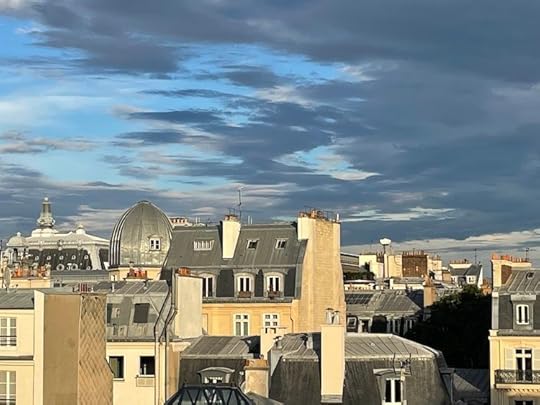
As for the hôtel during all this construction, it was bought and sold among nobles past the Revolution and into the 20th century. In 1956 it was purchased by an association of Catholic women who continued to rent it out.
When we moved here in 1997, the tenants were the Institute for Simplification (since nothing's simple, it didn't last long), an elderly couple with grown children who visited often and a troubled man who had been born here, the only child of a collaborator in the French militia during the War and a police officer thereafter. By 2015, the couple had died and the troubled man edged out.
In 2019, the hôtel was sold. We, the residents of the two other buildings, were happy because it was going to be a family home. Potted trees would replace the cars and parking spaces. Children skipping to school would replace lawyers and interior decorators (subsequent tenants to the Simplifiers) striding to and from work. We may have blanched mildly at the magnitude, but it all seemed for a good cause.
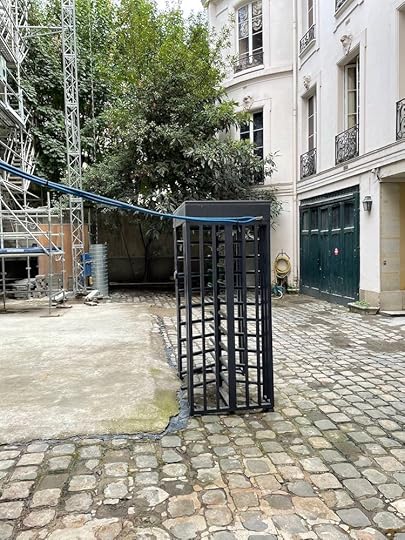
The chantier began after Covid lockdowns in 2020. As previously reported, the entire structure was covered in scaffolding and white plastic. The roof was removed. Once the new roof was in place and the plastic gone, work began on the garden. Out went the existing vegetation and in came the new. A vehicle ‘the size of a TGV car’, according to my neighbour, arrived in our street, and an enormous crane transported two iron basins over the two buildings and the courtyard, into the garden.
 Zen space
Zen spaceIt was about this time we heard that the Proprietor's personal circumstances, shall we say, had altered and so would plans for the hôtel. The top two floors would be office space. The basins in the garden were sawed into pieces (the noise, the noise!) and removed.
 Good-bye to all that
Good-bye to all thatThe plants were uprooted and many thrown away. Here's the state of the re-landscaping as I write:
 Re-Edening Eden
Re-Edening EdenMeanwhile, trenches were dug throughout the courtyard. Our front steps were removed and for months we had to cross a flimsy plank to enter.
 Drawbridge or gangplank?
Drawbridge or gangplank?Parking the car in the former carriage house, now our garage, has been difficult since the beginning...
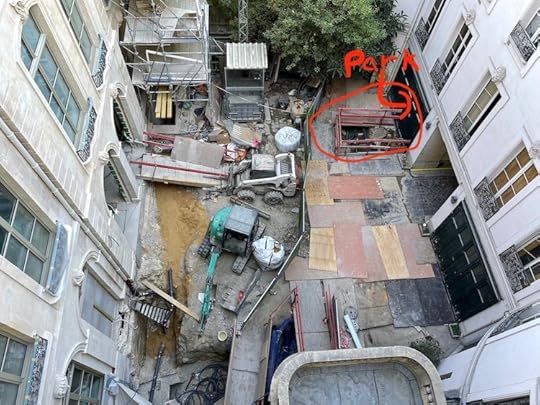
...and impossible since late August.
Finally, about a month ago, re-cobbling of the courtyard began. We learned that instead of potted trees, there will again be parking places for cars, plus chargers for the electric variety.
 So near and yet...
So near and yet...Just days before the last cobbles were cemented in place, the Proprietor visited the chantier and found them too widely spaced.
 Oh-my-God. Not again.
Oh-my-God. Not again. Like the garden, it is currently being dug up and refitted.
 Lost in spacing
Lost in spacingFor the last six months, we, the other residents, have complained, but we have little recourse beyond the frustration of feeling marginalised in our own homes.
Some days, I wonder if this isn't the hôtel particulier exacting vengeance after centuries of having its space and grandeur diminished. Others, it just seems like a new chapter in the saga of a swamp.
___________________
October 15, 2022
Safe Havens
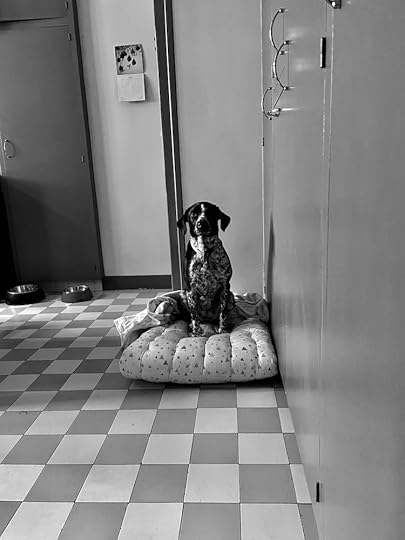
Friday, 14 October
Every morning I do a stupid thing. After some work and before walking Tasha, I peek at the news in the The Guardian's newsletter that arrives in my email box. Yesterday the cover photo showed four soulful sea lion pups and the headline said: "The Age of Extinction: almost 70% of animal populations wiped out since 1970," with us humans as the cause. Meanwhile, long Covid is ruining the lives of millions, further straining overburdened health systems and even affecting workforces. With winter on the way, the virus is again on the rise, along with the price of fuel (in France a strike is making the vehicle variety virtually unavailable) and the general cost of living. Most days there's a really scary article predicting how serious Vladimir Putin is about using nuclear weapons and what will happen if he does indeed push the button.
Already feeling shaky, I cross our courtyard with Tasha. It looks like this:
 Dog on an island in a sea of mud
Dog on an island in a sea of mudI open the door onto the street and we wriggle through this:

On the rue de Solférino, we squeeze by this:
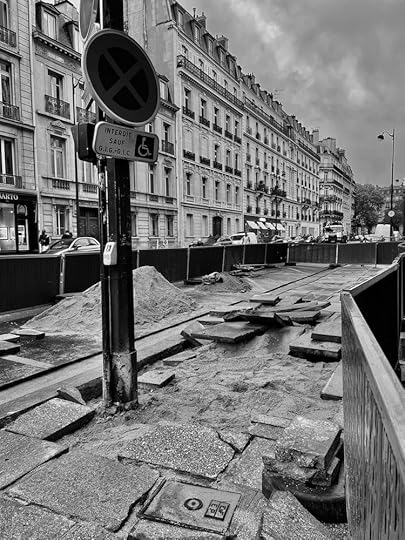
And it's only 7.30am.
Thankfully, Paris is more than her slatternly outward appearance these days implies. She has a rich interior life, a vast store of inner resources, including her 200+ museums, which offer both edification and refuge from outside chaos and depressing news. Now that the tourists have returned, the bigger, better known establishments such as the Louvre, the Musée d’Orsay or even the Orangerie, are packed so not much of a relief. But there are a trove of smaller museums all around the city. Generally, they are housed in beautiful places and are havens of tranquillity.
One of these gems is around the corner from us, on the rue de Lille. In 1947 the Dutch art historian and collector Frits Lugt bought an hôtel particulier (grand townhouse) and created the Fondation Custodia for his collection of 19th century European art, mostly drawings (7000) and prints (15,000). The Fondation displays a smattering from its permanent collection but also organises exhibitions. I visit often.
The stress nodes stop vibrating the minute you walk under the porte-cochère.
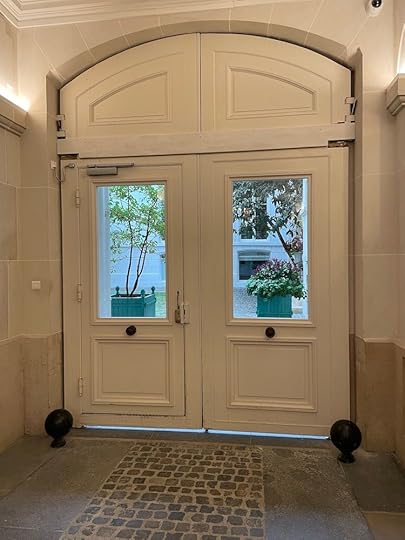
The foyer still looks like a well-kept residence.
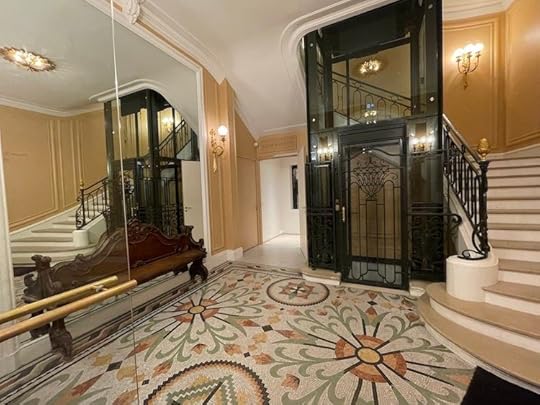
Upstairs are the works from the permanent collection. As you can see, crowds are usually not a problem.
 Opening hours
Opening hoursThe basement is reserved for temporary exhibitions, and yesterday afternoon, alerted by my friend Louise D, I went to see a new show that was the perfect antidote to the morning's assault on my senses and sensibility:
 Catalogue cover
Catalogue coverLéon Bonvin was the younger half-brother of the better known François Bonvin. After a hardscrabble childhood, his day job was running the humble inn inherited from his father in Vaugirard, then a small village and now the XV arrondissement of Paris, but he dreamed of living from his art. The early works were pencil drawings that recorded the world around him, including the café, outside...

...and in...

Gradually he brought in watercolours and shifted to nature as his main subject matter, first in Dutch or Chardin inspired still-lifes.
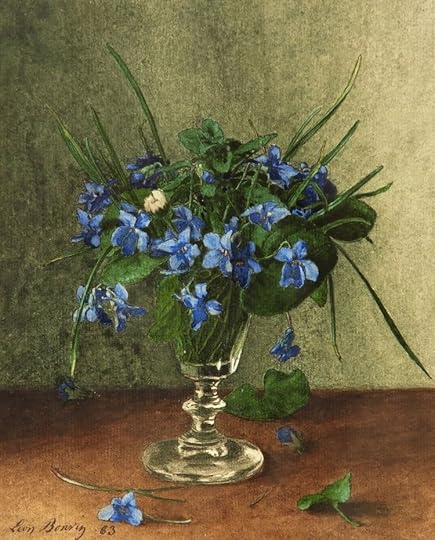
And later as scenes from his morning rambles around the Vaugirard countryside.

Walking through a retrospective, you are plunged into the artist's life, are taken step by step along the creative trajectory. You see how one theme or technique spins into another, meanwhile following the threads that are constant throughout. It's always an intense experience, but at a blockbuster show in a big museum, the force of the encounter is tempered by bobbing and ducking to see the art and, in my case, by fighting agoraphobia. Often you're already familiar with a substantial part of the famous artist's oeuvre.
With Léon Bonvin, in the windowless, all but empty basement of the Fondation Custodia, it was pure discovery, an uninterrupted moment of deep connection. The delicate intimacy of his work was both exhilarating and familiar. It moved me deeply.
I don't have to look far to know why. No further than my own photographs, which echo his perspective...
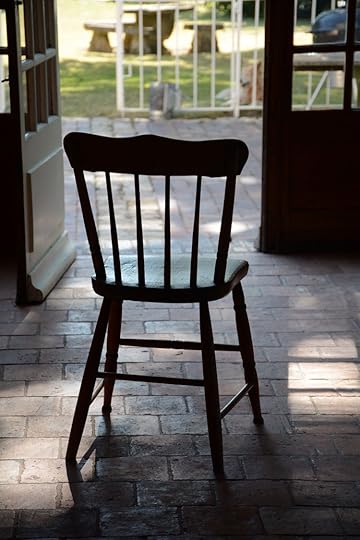
...subject matter...
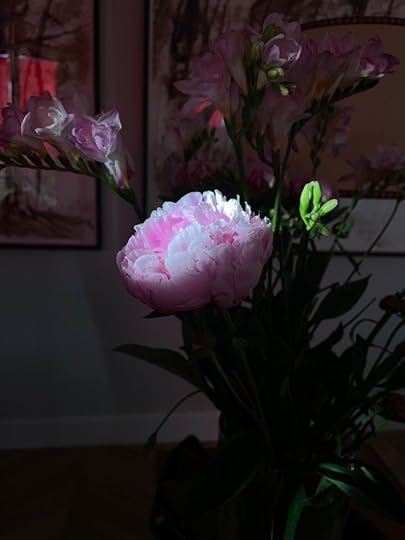
...and choice of silhouette during country morning walks...

Often at exhibitions I don't pay much attention to the biographical information until later; I like to experience the work in isolation from the life. So it was a shock when I got to the last room of his paintings, and my eye caught these words: “In January 1866, Léon Bonvin committed suicide in the Forêt de Meudon.” The text was right next to the show's only self-portrait, painted 10 days before his death and dedicated to his wife.
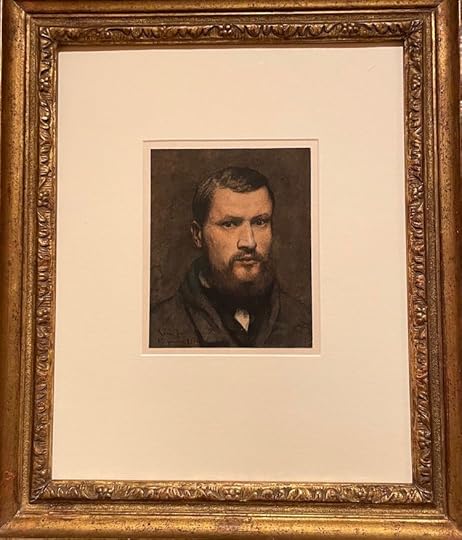
It was like hearing tragic news about a person I’d recently struck up a friendship with, but given the melancholy strain running through his work, the shock was not entirely a surprise.
Despite his sad end, I emerged from the museum feeling spiritually richer and - even if it won't last - sublimely removed from the troubles of the temporal world.
Needless to say, I highly recommend the Fondation Custodia, both its permanent collection and the Léon Bonvin exhibition, on until 8 January 2023. Just don’t tell too many of your friends.
___________________
October 1, 2022
Team Claire

Friday, 30 September
“What about the garden?” my husband David began asking two years ago, not long after the renovation of the inside of our Perche house got underway. As regular readers know, it has been a refrain ever since.
For more recent readers, and since I have trouble keeping track myself, here’s a recap:
We bought Deux Champs in 2019, thus reuniting a 1ha/2.5acre house and garden with 20ha/50 acres of fields. Fences and hedges that had grown into trees closed around the garden. The thuja that lined the lane had grown into monsters and blocked the view of the orchard and fields beyond. The courtyard still looked much like the farmyard it had been 30 years earlier.
Fortunately, we quickly found garden guru Claire. With the help of Estéban and Yohann, she wasted no time in freeing the garden from its vegetal prison. Hedges were thinned or plessées.
 Estéban's art
Estéban's artField maples were pollarded and replanted (fyi, you horticulturists out there, even full grown trees can be dug up and moved) beyond the garden's former confines. The thuja were summarily chopped down and turned into firewood and wood chips. Earth was turned and a couple of new trees and beds were planted, but that was about it.
Okay, I admit that's already quite a lot, but work was very far from done, and as long as the house renovation continued (and continued), there was no point taking on the full job. Every day heavy vehicles rolled over the ground, and the court/farmyard when not a parking lot was depressingly littered with cement mixers and debris.
In my last garden update, the house had finally reached a stage where the ground could be landscaped. But by now late July, it was too hot and dry to plant and everyone was going on holiday, so the earth was left to languish in its desolate brownness.
 Au secours
Au secoursIt was super depressing and didn’t get any better when a big storm in August caused an explosion of weeds to emerge on the bare earth and in the existing beds. David and I did our weeding best, but we were no match for nature unbound.
 Just you try and get rid of us
Just you try and get rid of usHope, however, returned in the early days of September, when Team Claire moved into action. She and Samuel mowed, ripped and raked...
 Take that, Weeds!
Take that, Weeds!...and replaced the intruders with much prettier specimens...
 Casting a long shadow
Casting a long shadowA large shipment of plants arrived...
 Smells okay to me
Smells okay to meThe Team grew. Claire got her daughter Jessie in on the act…
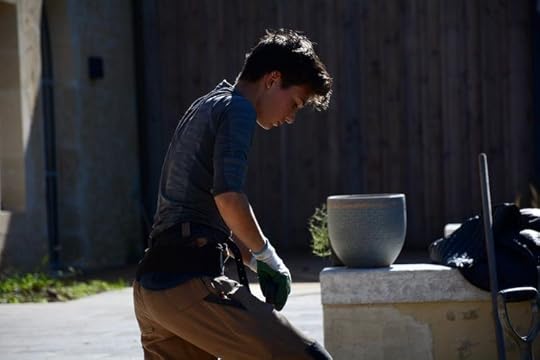
…and Florie…
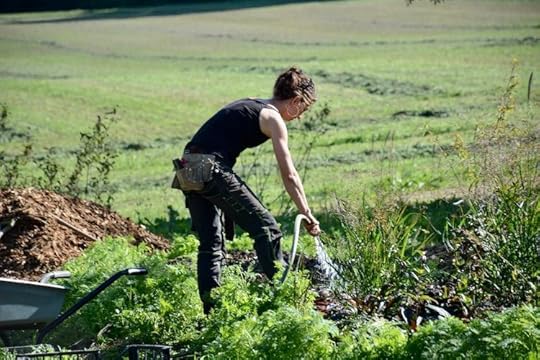
…and Gladys...
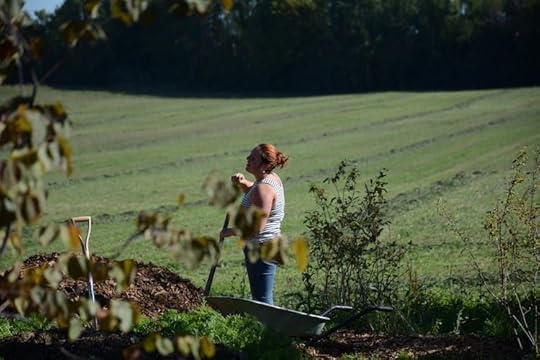
As I write, there's still much to do - including the sowing of the lawn - but many of the 1100 tiny plants are already taking root in their new home, surrounded by wood chips to keep water in and weeds out (mauvaises herbes are clever bastards, Claire says, and need much dissuasion).
With climate change, the front of the house now gets relentless, blistering sun in the summer and is therefore of Mediterranean inspiration. "It'll give all year round interest and smells," says Claire. Lots of rosemary and thyme and lavender; cistus, santolinas, helichrysum and phillyrea, plus drought resistant grasses and small trees that can take the heat. Out back is more "prairie style planting to link with the meadow, ornamental grasses and windbreak. Miscanthus sinensis graziella (love that name), panicum northwind, asters, willows and sages...that kind of stuff."
It is inspiring and reassuring to watch Team Claire work together and impose order on chaos; really, it's as much about the people as it is the planting, especially when the world beyond the garden feels so fractious and beyond the individual's control.
David finally has the answer to what-about-the-garden.
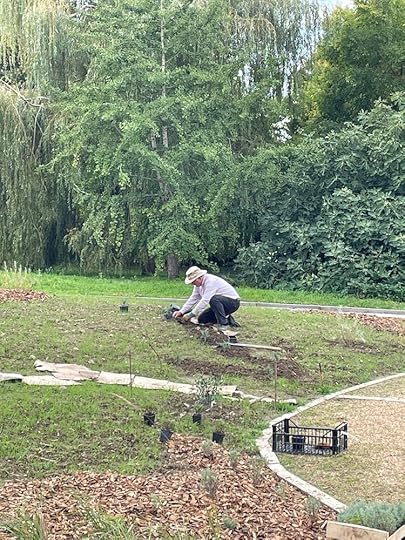
Time for me to stop writing about the planting and start helping get the new arrivals into the ground. But first, a big thank you to Team Claire.
 The master minding
The master minding
September 17, 2022
It's a Long Story

Friday, 16 September
Trick question: what is the oldest monument in Paris?
People who don't know the city well might answer Notre Dame (1163-1345), but Our Lady isn't even the oldest church, with Saint-Germain-des-Près preceding it by a few hundred years (founded in 558 by Childebert I, rebuilt at the end of the 10th century and remodelled multiple times since).
Others who know the city a bit better might think of Roman remnants in the 5th arrondissement such as the Cluny thermal baths (1st century) or the Arènes de Lutèce amphitheatre (2nd century).
They’d all be wrong by several millennia. The oldest monument in Paris is the Luxor Obelisk on the place de la Concorde, the gold tip of which you can just see, top right, in the above photo. Of course the 1290 BCE granite column wasn't actually built in the city, just transported here in 1829 when the vice-pasha of Egypt offered it to France after Jean-François Champollion cracked the code of hieroglyphics.
An odd fact about an odd relic on an odd piece of Paris property.
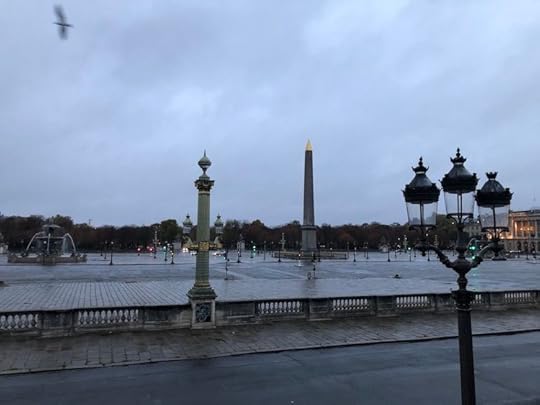
The place, right across the Seine from our apartment, is a daily feature of my life. The terraces of the Tuileries, where I walk Tasha every morning, overlook it.
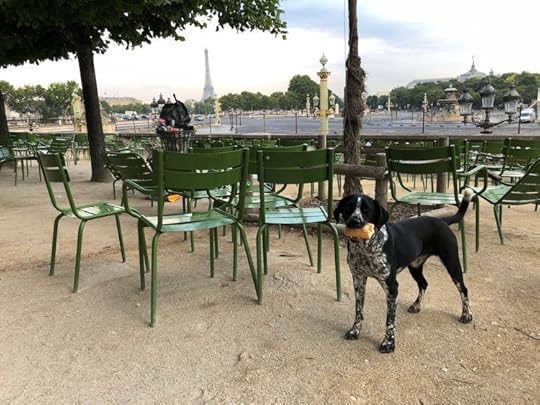
Trips to the Right Bank often require cycling across it, a perilous exercise given that nervy Parisian drivers become particularly aggressive on its un-demarcated cobbled vastness. A few years ago a bike path was designated around the side, so now you can choose your poison.
 A dog's eye view
A dog's eye viewLast Sunday morning, in my attempt to wear down The Indefatigable One (aka Tasha), I was riding my bike with the dog across a blissfully calm place, on our way from the Tuileries to the Jardins des Champs Elysées. It struck me that there’s a lot of empty grey matter for a quartier of Paris where apartments sell for 18,000€ a square metre ($8000 a square foot). The 8ha/20 acre plot may be a classified historical monument with, besides the obelisk, two fountains, statued sentinel towers representing the eight largest cities of France (after Paris) and lots of fancy street lamps, but it is essentially a roundabout surrounded by inhospitable swathes of bare stone.
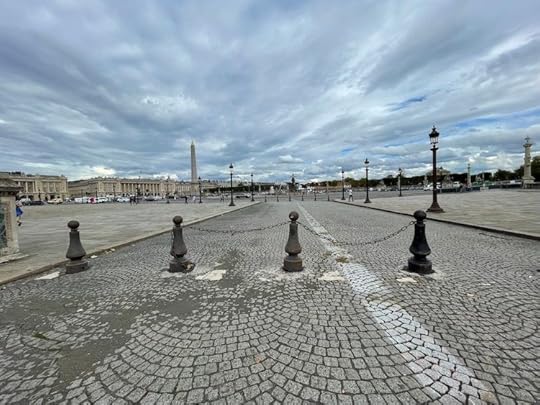
Yes, crowds form for parades and the arrival of the Tour de France. Nicolas Sarkozy delivered his presidential victory speech there in 2007. Fashion shows and trade fairs erect big tents next to the Tuileries entrance that block the view (top photo again). Protestors gather to demonstrate.
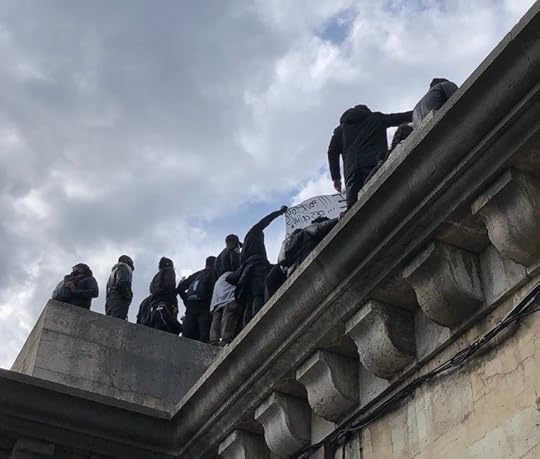
But most of the time, it's not a fun place to hang out; there isn't even anywhere to sit.
 No seating here
No seating hereIn our climately challenged world, I wondered as I bumped over stone after stone, wouldn’t it be better to replace some of the mineral expanse with greenery? To return to its 1772 roots, so to speak, when flower beds spread underneath the balustrades? You could forgo the equestrian statue of King Louis XV, after whom the place was originally named, and the monarchy.
Like the country did twenty years later. In 1792, the square was renamed place de la Révolution and the following year hosted King Louis XVI and his wife Marie-Antoinette when they lost their heads. A year after that, it was the other side, the Reign of Terror leaders - Robespierre and Danton, for example - who were getting the chop. In the space of three years, 1119 people were guillotined right here:
 One monarch loses a statue, another his head (engraving by Isidore Stanislas Helman)
One monarch loses a statue, another his head (engraving by Isidore Stanislas Helman)Once the blood letting stopped in 1795, it was dubbed place de la Concorde as a sign of reconciliation. Until the restoration of the monarchy, at least, when the name was back to Louis XV, then Louis XVI. It got reattributed Concorde following the July Revolution of 1830. Vive stable governance.
During World War II, the German occupiers went around it in their tanks and later, during the Liberation, took potshots at Parisiens daring to celebrate.
 German sniper shooting on the recently Liberated (army photo)
German sniper shooting on the recently Liberated (army photo)With such a fraught history, why would you even want all that empty space where huge crowds can amass?
My weekend mental meanderings got at least a partial answer on Wednesday.
The whole square, it was announced, will soon receive a 700,000 - 900,000€ facelift. The obelisk, owned by the state rather the municipality, already got a scrub earlier this year...
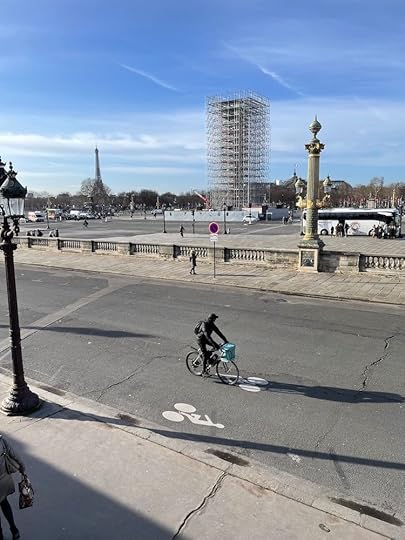
...and now, following more hectoring from the #SaccageParis movement, once again with the support of culture guru Stéphane Bern, the place will follow suit.
She is, as Monsieur Bern intoned, "in a pitiful state". The blemished statuary, for example...
 Ouch - my hand hurts. And I could use a bath.
Ouch - my hand hurts. And I could use a bath....or the fountains, which have been afflicted by Paris' hard water...
 Skin problems
Skin problemsOf course the real reason the Mairie de Paris is reacting so promptly to #SaccageParis complaints is that the 2024 Olympics are right around the corner. Given that the whole city is under siege by pre-game construction, it's astonishing the urban authorities needed a nudge.
During the Olympic invasion, the place de la Concorde will, I learned, be transformed into a 30,000 seat arena. The opening ceremony will be hosted here. Planned sporting events include the very 21st century 3 x 3 basketball (I had to look this one up), BMX free style, break-dancing, skateboarding and climbing.
Enough to turn the severed heads of Louis and Robespierre over in their graves, to send the Luxor obelisk hopping back to the banks of the Nile.

Thus the next chapter in the colourful history of this grey square begins. How does place de la Break-Dance grab you?
___________________



